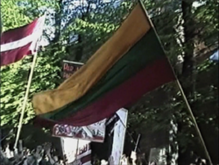Latvijas Tautas Fronte
The Latvijas Tautas fronte ( Latvian Popular Front ) was a political organization in Latvia in the late 1980s and early 1990s that led the country to independence from the Soviet Union . It is comparable to the Estonian Popular Front and the Sąjūdis movement in Lithuania .
Her newspaper Atmoda ( Awakening ) appeared in Latvian and Russian from 1989 to 1992.
Historical background
Like Estonia and Lithuania, Latvia was occupied by the Soviet Union in 1940 . To avoid bloodshed, there was relatively little visible resistance to the occupation , but many Latvians were deeply dissatisfied and waited for an opportunity to regain independence. One such opportunity arose in the 1980s when Gorbachev tried to reform the Soviet Union. Gorbachev's glasnost policy in particular helped, as it allowed a greater degree of freedom of speech in the Soviet Union than ever before.
The Latvian independence movement began in 1986 with small demonstrations for independence and human rights organized by the Helsinki-86 group and suppressed by the government of the Latvian SSR . The breakthrough came in the summer of 1988. Many prominent Latvians publicly expressed their support for the demand for more autonomy. The Latvian newspapers began to write about aspects of Latvian history that had previously been banned, such as the occupation of 1940. The flag of Latvia , also previously banned, returned and a new strong wave of Latvian national identity swept through the country.
The Popular Front from 1988 to 1990
This wave created various political organizations dedicated to increasing the autonomy or independence of Latvia. Of these, Latvijas Tautas fronte was the largest. It was founded on October 9, 1988. In the beginning, Tautas fronte took a moderate position, demanding extensive autonomy for Latvia, but held back from calling for independence. The Popular Front was supported by moderate members of the leadership of the Latvian SSR, but opposed by their hardliners.
Tautas fronte quickly grew to 250,000 members. Their goal was to create a broad coalition of all forces that advocated autonomy or independence. Because 48% of the population in the territory of the SSR were non-Latvians (mainly people who had moved from other parts of the Soviet Union), attempts were also made to reach the national minorities . In addition, the Popular Front spoke out in favor of the right to schooling in languages other than Latvian and Russian. At the same time, however, she worked with much more radical Latvian independence movements.
The prevailing conviction within the Latvian Popular Front about the goal to be achieved gradually shifted from autonomy within the Soviet Union to full independence. On May 31, 1989, she announced that the government of the Soviet Union had not shown sufficient co-operation with the Latvian desire for autonomy and that an independent Latvia had become the only option.
In 1989 and 1990, the first free elections since the Soviet occupation in 1940 were held in Latvia. The most important was the election for the Supreme Soviet , the parliament of the Latvian SSR , on March 18, 1990 . The Independence Alliance, led by the Tautas fronte, won 138 out of 201 seats.
The Popular Front from 1990 to 1993
After these elections, Tautas fronte became the ruling party in Latvia, and on May 4, 1990, the first law was passed by the new Supreme Soviet declaring Latvia's intention to restore independence. Dainis Īvans , chairman of the Popular Front, became speaker of parliament and his deputy, Ivars Godmanis, became prime minister. Many other members of Tautas fronte held key positions in the Latvian government.
The situation in Latvia from May 1990 to August 1991 was tense. Independence was not recognized by the government of the Soviet Union and there was a threat of military crackdown on Latvian independence efforts.
At Riga Old Town bank of the Daugava Soviet tanks appeared. The television broadcast the sounds of night shootings in the old town. Barricades were erected on the streets and unarmed civilians who sang Latvian songs were guarded day and night. That is why these events are also known today as the "singing revolution".
Latvia's independence was recognized in August 1991. Thus the main political aim of Tautas fronte was achieved. But now she was faced with an incomparably more difficult task: to convert the previous state socialist central administration economy into a market economy system. The economic transition was very difficult, with the gross national product halving between 1990 and 1993. As the economy deteriorated, Prime Minister Godmanis' popularity declined. Many politicians left the Latvian Popular Front and formed new parties so as not to be associated with the unpopular government.
The end of the popular front
In June 1993 Latvia held its first elections since regaining independence. The Latvian Popular Front, weakened by the economic difficulties and the departure of many of its politicians, achieved just 2.62% of the vote and not a single parliamentary seat. It tried to renew itself as a Christian Democratic party and changed its name to Jaunā Kristīgā partija ( New Christian Party ), but was unsuccessful. Eventually she went into another party of the Kristīgi Demokratiskā savienība ( Christian Democratic Union ).
legacy
All or almost all of Tautas fronte's objectives have been achieved. Latvia is now an independent country with Latvian as the only official language . Its economy and politics, which used to be communist and oriented towards the Soviet Union, are now market-based and democratic. Although the Latvian Popular Front ceased to exist during the economic troubles in the mid-1990s, many of its former activists play important roles.
